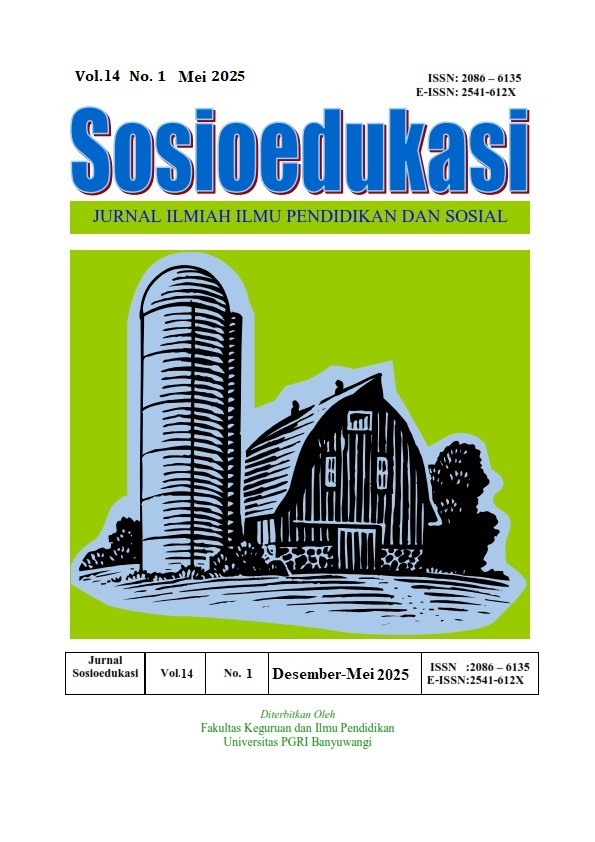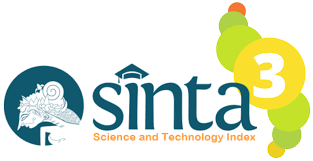Perception of the Wogo Village Community Regarding the Waja Betho Tradition in Bamboo Forest Conservation
Persepsi Masyarakat Desa Wogo Mengenai Tradisi Waja Betho Dalam Pelestarian Hutan Bambu
DOI:
https://doi.org/10.36526/sosioedukasi.v14i1.5410Keywords:
Community Perception, Waja Betho Tradition, Bamboo ForestAbstract
Bamboo is a versatile plant that offers a diversity of ecosystem services for the environment, so its existence needs to be preserved. The existence of bamboo in rural areas, especially in Wogo Village, is closely related to the culture and traditions of the local community, which can be used to regulate the lifestyle of the community towards the existence and preservation of bamboo forests. Community perception will help see the perspective, response and sensing of a group of people in an area towards events or phenomena that occur in their environment. This research examines community perceptions of the Waja Betho Tradition, as one of the community's local knowledge in relation to the preservation of bamboo forests. To explore information about the data, a descriptive qualitative method is used and the search for accurate information data in the field through observation, interview and documentation techniques to be able to study more deeply. Based on the results obtained, it can be concluded that some village communities already have the perception that the waja betho tradition which is an ancestral heritage plays an important role in the preservation of bamboo forests. The community's perception of the waja betho tradition in preserving bamboo forests is influenced by individual interests, interaction with the environment and economic motives. The waja betho tradition also contains environmental conservation values in this case to preserve bamboo, where there is a prohibition on harvesting bamboo for a specified period of time to keep the bamboo able to grow lush and quality, before it can finally be used again.
References
Ayer, S., Timilsina, S., Aryal, A., Acharya, A. K., Neupane, A., & Bhatta, K. P. (2023). Bamboo Forests in Nepal: Status, Distribution, Research Trends and Contribution to Local Livelihoods. Advances in Bamboo Science, 4, 100027. https://doi.org/10.1016/j.bamboo.2023.100027
Bain, W. K. (2021). Traditional Wisdom and Practices Involved in Bamboo Based Crafts of the Lepcha Community of North Sikkim-A Case Study from Dzongu Reserve Area. Heritage: Journal of Multidisciplinary Studies in Archaeology, 9, 608–630.
Ben-zhi, Z., Mao-yi, F., Jin-zhong, X., Xiao-sheng, Y., & Zheng-cai, L. (2005). Ecological Functions of Bamboo Forest: Research and Application. Journal of Forestry Research, 16(2), 143–147. https://doi.org/10.1007/BF02857909
Irawan, B., Partasasmita, R., Rahayu, N., Setiawati, T., & ISKANDAR, J. (2019). Indigenous Knowledge of Bamboos by Naga Community, Tasikmalaya District, West Java, Indonesia. Biodiversitas Journal of Biological Diversity, 20(5), 1423–1434. https://doi.org/10.13057/biodiv/d200535
Lacerda, A. E. B., & Kellermann, B. (2019). What is the Long-Term Effect of Bamboo Dominance on Adult Trees in the Araucaria Forest? A Comparative Analysis between Two Successional Stages in Southern Brazil. Diversity, 11(9), 165. https://doi.org/10.3390/d11090165
Li, W., Shi, C., Li, K., Zhang, Q.-J., Tong, Y., Zhang, Y., Wang, J., Clark, L., & Gao, L.-Z. (2021). Draft Genome of The Herbaceous Bamboo Raddia Ristichophylla. G3 Genes|Genomes|Genetics, 11(2). https://doi.org/10.1093/g3journal/jkaa049
Luo, Y., & Feng, X. (2023). A Comparative Analysis between Timber Industry and Nontimber Forest Products Industry in Relation to Sustainability and Operators’ Proactiveness. Forest Products Journal, 73(2), 94–103. https://doi.org/10.13073/FPJ-D-22-00065
Meena, R. K., Bhandhari, M. S., Barhwal, S., & Ginwal, H. S. (2019). Genetic Diversity and Structure of Dendrocalamus Hamiltonii Natural Metapopulation: a Commercially Important Bamboo Species of Northeast Himalayas. 3 Biotech, 9(2), 60. https://doi.org/10.1007/s13205-019-1591-1
Mekonnen, A., Fashing, P. J., Chapman, C. A., Venkataraman, V. V., & Stenseth, N. Chr. (2022). The Value of Flagship and Umbrella Species for Restoration and Sustainable Development: Bale Monkeys and Bamboo Forest in Ethiopia. Journal for Nature Conservation, 65, 126117. https://doi.org/10.1016/j.jnc.2021.126117
Mohan, N., Dash, S. P., Mary Boby, N., & Shetty, D. (2022). Study of Bamboo as a Building Material – Construction & Preservation Techniques and its Sustainability. Materials Today: Proceedings, 60, 100–114. https://doi.org/10.1016/j.matpr.2021.12.263
Noywuli, N., Sapei, A., H. Pandjaitan, N., & Eriyatno, E. (2019). Kebijakan Pengembangan Budidaya Tanaman Bambu untuk Pengelolaan Berkelanjutan DAS Aesesa Flores. Jurnal Pengelolaan Sumberdaya Alam Dan Lingkungan (Journal of Natural Resources and Environmental Management), 9(4), 946–959. https://doi.org/10.29244/jpsl.9.4.946-959
Paembonan, S. A., Bachtiar, B., & Larekeng, S. H. (2019). Vegetative Propagation with Branch Cuttings as a Solution for The Mass Development of Giant atter Species (Gigantochloa Atter (Hassk) Kurz) in Industrial Plantations. IOP Conference Series: Earth and Environmental Science, 343(1), 012049. https://doi.org/10.1088/1755-1315/343/1/012049
Qiao, Z., Sun, S., Jiang, Q., Xiao, L., Wang, Y., & Yan, H. (2021). Retrieval of Total Phosphorus Concentration in the Surface Water of Miyun Reservoir Based on Remote Sensing Data and Machine Learning Algorithms. Remote Sensing, 13(22), 4662. https://doi.org/10.3390/rs13224662
Saung, T., Khai, T. C., Mizoue, N., Ota, T., & Kajisa, T. (2021). Condition of Illegally Logged Stands Following High Frequency Legal Logging in Bago Yoma, Myanmar. Forests, 12(2), 115. https://doi.org/10.3390/f12020115
Sujarwanta, A., & Zen, S. (2023). Pelestarian Tanaman Bambu Sebagai Upaya Konservasi Daerah Aliran Sungai Way Semaka Lampung. Jurnal Lentera Pendidikan Pusat Penelitian LPPM UM Metro, 8(1), 139–146. https://doi.org/10.24127/JLPP.V8I1.2877
Sumarmi, Su., Wahyuningtyas, N., Sahrina, A., & Mutia, T. (2022). Analysis of The Potential Bamboo Forest as an Effort Towards Local Wisdom-Based Ecotourism in Sustainable Spring Conservation. Journal of Ecology and Environment, 46, 14. https://doi.org/10.5141/jee.22.032
Utomo, A. P. (2018a). Kearifan Lokal dalam Pembuatan Angklung Paglak sebagai Sumber Etika Lingkungan. Bioma : Jurnal Biologi Dan Pembelajaran Biologi, 3(2), 1–10. https://doi.org/10.32528/BIOMA.V3I2.1615
Utomo, A. P. (2018b). Local Ecological Knowledge in Angklung Paglak of Using Community of Banyuwangi, Indonesia. Applied Ecology and Environmental Research, 16(3), 3215–3228. https://doi.org/10.15666/aeer/1603_32153228
Yasin, I., & Priyanto, A. (2019). Analysis of Bamboo Mechanical Properties as Construction Eco-Friendly Materials to Minimizing Global Warming Effect. IOP Conference Series: Materials Science and Engineering, 535(1), 012001. https://doi.org/10.1088/1757-899X/535/1/012001
Yeny, I., Yuniati, D., & Khotimah, H. (2016). Kearifan Lokal dan Praktik Pengelolaan Hutan Bambu pada Masyarakat Bali. Jurnal Penelitian Sosial Dan Ekonomi Kehutanan, 13(1), 63–72. https://doi.org/10.20886/jpsek.2016.13.1.63-72









.png)

















